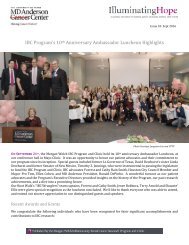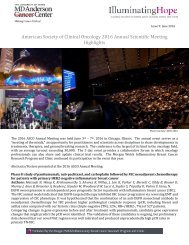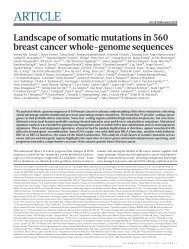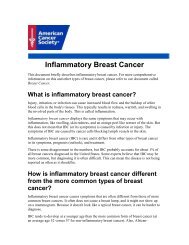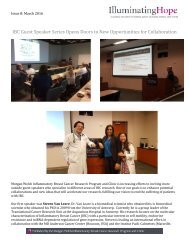IBC -what we know and what we need to learn
Create successful ePaper yourself
Turn your PDF publications into a flip-book with our unique Google optimized e-Paper software.
896 Inflamma<strong>to</strong>ry Breast Cancer<br />
Chemotherapy<br />
A report on a 20-year experience at MD Anderson sho<strong>we</strong>d that<br />
anthracycline-based chemotherapy in patients with <strong>IBC</strong> resulted<br />
in overall survival rates of 40% at 5 years <strong>and</strong> 33% at 10<br />
years [31]. In addition, several retrospective studies have explored<br />
the efficacy of anthracycline-based chemotherapy regimens<br />
typically used <strong>to</strong> treat non-<strong>IBC</strong> [31–34]. One cohort<br />
study of 68 patients with <strong>IBC</strong> treated with three cycles of either<br />
cyclophosphamide, doxorubicin, <strong>and</strong> 5-fluorouracil or cyclophosphamide,<br />
epirubicin, <strong>and</strong> 5-fluorouracil follo<strong>we</strong>d by surgery,<br />
adjuvant therapy, <strong>and</strong> radiation therapy in two<br />
prospective r<strong>and</strong>omized trials sho<strong>we</strong>d overall survival rates of<br />
44% at 5 years <strong>and</strong> 32% at 10 years [37].<br />
An initial report from investiga<strong>to</strong>rs at MD Anderson<br />
sho<strong>we</strong>d that taxane-based combination chemotherapy was as<br />
effective as neoadjuvant treatment for <strong>IBC</strong> [35]. In a cohort of<br />
178 patients with <strong>IBC</strong>, the same investiga<strong>to</strong>rs demonstrated a<br />
benefit from the addition of paclitaxel <strong>to</strong> fluorouracil, doxorubicin,<br />
<strong>and</strong> cyclophosphamide [36]. The benefit was more pronounced<br />
in patients with estrogen recep<strong>to</strong>r–negative <strong>IBC</strong>.<br />
Currently, the sequence of taxane-based chemotherapy follo<strong>we</strong>d<br />
by anthracycline-based chemotherapy is the corners<strong>to</strong>ne<br />
of primary systemic therapy for <strong>IBC</strong> at MD Anderson.<br />
Targeted Therapy<br />
Several molecular c<strong>and</strong>idates for targeted therapy for <strong>IBC</strong><br />
have been investigated; so far, therapies targeted <strong>to</strong> HER-2 <strong>and</strong><br />
epidermal growth fac<strong>to</strong>r recep<strong>to</strong>r (EGFR) have proven <strong>to</strong> be<br />
clinically beneficial.<br />
HER-2 is overexpressed or amplified in 36%–60% of<br />
cases of <strong>IBC</strong> [38–40]. Trastuzumab in combination with systemic<br />
chemotherapy for locally advanced breast cancer, including<br />
<strong>IBC</strong>, has been investigated in several prospective trials<br />
[41–45]. The results of these trials suggested that combinations<br />
of trastuzumab <strong>and</strong> systemic chemotherapy have a role in<br />
the treatment of <strong>IBC</strong>.<br />
Lapatinib is an oral dual tyrosine kinase inhibi<strong>to</strong>r of EGFR<br />
<strong>and</strong> HER-2. Clinical trials sho<strong>we</strong>d that lapatinib has efficacy<br />
similar <strong>to</strong> that of trastuzumab in patients with HER-2 breast<br />
cancer. Lapatinib is used for the treatment of <strong>IBC</strong>, which has a<br />
rate of HER-2 positivity higher than that of non-<strong>IBC</strong> [40]. Preliminary<br />
results from a phase II trial of lapatinib <strong>and</strong> paclitaxel<br />
as neoadjuvant therapy in patients with newly diagnosed <strong>IBC</strong><br />
sho<strong>we</strong>d that 95% of the HER-2 patients had a clinical response<br />
[46]. Currently, the European Organization for Research<br />
<strong>and</strong> Treatment of Cancer is conducting a r<strong>and</strong>omized<br />
phase I/II trial of lapatinib <strong>and</strong> docetaxel as neoadjuvant therapy<br />
in patients with HER-2 locally advanced breast cancer,<br />
<strong>IBC</strong>, or resectable breast cancer [47]. At MD Anderson, a<br />
phase II study of neoadjuvant lapatinib plus systemic chemotherapy<br />
(sequential 5-fluorouracil, epirubicin, <strong>and</strong> cyclophosphamide<br />
<strong>and</strong> paclitaxel) in patients with HER-2 <strong>IBC</strong>isin<br />
progress [48]. Further, the combination of a his<strong>to</strong>ne deacetylase<br />
inhibi<strong>to</strong>r <strong>and</strong> an aromatase inhibi<strong>to</strong>r plus a tyrosine kinase<br />
inhibi<strong>to</strong>r of insulin-like growth fac<strong>to</strong>r is currently being tested.<br />
Molecular targets in vasculolymphatic processes—angiogenesis,<br />
lymphangiogenesis, <strong>and</strong> vasculogenesis—have<br />
shown greater potential for <strong>IBC</strong> than for non-<strong>IBC</strong> [49]. High<br />
expression of angiogenic fac<strong>to</strong>rs has been observed in <strong>IBC</strong>,<br />
<strong>and</strong> antiangiogenesis therapies (bevacizumab <strong>and</strong> semaxanib)<br />
have shown some clinical effect in clinical trials [50, 51]. Lymphangiogenesis<br />
may play an important role in the early spread<br />
of disease <strong>to</strong> lymph nodes in patients with <strong>IBC</strong>. Vasculogenesis<br />
might be related <strong>to</strong> hema<strong>to</strong>genous metastasis in <strong>IBC</strong> <strong>and</strong><br />
has been extensively investigated in a human <strong>IBC</strong> mouse xenograft<br />
model.<br />
Comparison of gene expression bet<strong>we</strong>en human <strong>IBC</strong> <strong>and</strong><br />
stage-matched non-<strong>IBC</strong> tumor samples revealed overexpression<br />
of RhoC <strong>and</strong> loss of WISP3 in <strong>IBC</strong> [52]. RhoC is a member<br />
of the Ras superfamily <strong>and</strong> is involved in cy<strong>to</strong>skele<strong>to</strong>n<br />
regulation [53]. The use of farnesyltransferase inhibi<strong>to</strong>rs <strong>to</strong><br />
modulate RhoC expression has been investigated in preclinical<br />
studies <strong>and</strong> has potential as a novel targeted therapy for tumors<br />
that overexpress RhoC, including <strong>IBC</strong> [54, 55]. Neoadjuvant<br />
chemotherapy with the farnesyltransferase inhibi<strong>to</strong>r tipifarnib<br />
in combination with doxorubicin <strong>and</strong> cyclophosphamide was<br />
tested in a phase II trial <strong>and</strong> was associated with a 25% rate of<br />
pathological complete response accompanied by decreasing<br />
farnesyltransferase enzyme activity [56].<br />
E-cadherin expression has been observed <strong>to</strong> be high in<br />
<strong>IBC</strong>. Generally, E-cadherin expression decreases when cancer<br />
progresses, <strong>and</strong> loss of E-cadherin expression is related <strong>to</strong> epithelial–mesenchymal<br />
transition [57–61]. This unique pattern<br />
of E-cadherin expression in <strong>IBC</strong> could make E-cadherin a target<br />
for treatment of <strong>IBC</strong>, <strong>and</strong> this strategy has been investigated<br />
in <strong>IBC</strong> xenografts [58]. EIF4G1, recently discovered <strong>to</strong><br />
be the target gene of eukaryotic translation initiation fac<strong>to</strong>r 4,<br />
may be related <strong>to</strong> the role of E-cadherin in <strong>IBC</strong> [62]. Overexpression<br />
of this gene was observed more frequently in <strong>IBC</strong> tumors<br />
(80%) than in normal cells <strong>and</strong> non-<strong>IBC</strong> cells.<br />
Surgery<br />
Surgery plays an important role in the multimodal treatment of<br />
<strong>IBC</strong>. His<strong>to</strong>rically, mastec<strong>to</strong>my as the sole treatment failed <strong>to</strong><br />
produce any survival benefit in patients with <strong>IBC</strong>; 5-year survival<br />
rates after surgery alone <strong>we</strong>re 0%–10% [63]. In contrast,<br />
several retrospective studies have shown that surgery results in<br />
higher local control rates <strong>and</strong> better survival outcomes for patients<br />
who respond <strong>we</strong>ll <strong>to</strong> neoadjuvant chemotherapy [64].<br />
The optimal surgical procedure for patients who respond <strong>to</strong><br />
neoadjuvant chemotherapy is mastec<strong>to</strong>my with axillary lymph<br />
node dissection. The goal of surgery should be complete resection<br />
of residual gross disease with negative surgical margins; a<br />
better prognosis has been reported for patients with negative<br />
margins [65, 66]. The most appropriate c<strong>and</strong>idates for surgery<br />
are patients for whom negative margins are anticipated.<br />
Axillary lymph node involvement is noted in 55%–85% of<br />
patients with <strong>IBC</strong> at the time of presentation [21]. Axillary<br />
lymph node status is a predic<strong>to</strong>r of survival outcome; therefore,<br />
complete axillary lymph node dissection is st<strong>and</strong>ard of care for<br />
<strong>IBC</strong> patients. Although sentinel lymph node biopsy (SLNB)<br />
has been accepted as the st<strong>and</strong>ard of care <strong>to</strong> evaluate axillary<br />
lymph node status in patients with early breast cancer, SLNB is<br />
not recommended for patients with <strong>IBC</strong> because of lymphatic<br />
Downloaded from http://theoncologist.alphamedpress.org/ at UNIV OF TX MD ANDERSON CANCER CT on Oc<strong>to</strong>ber 31, 2015



